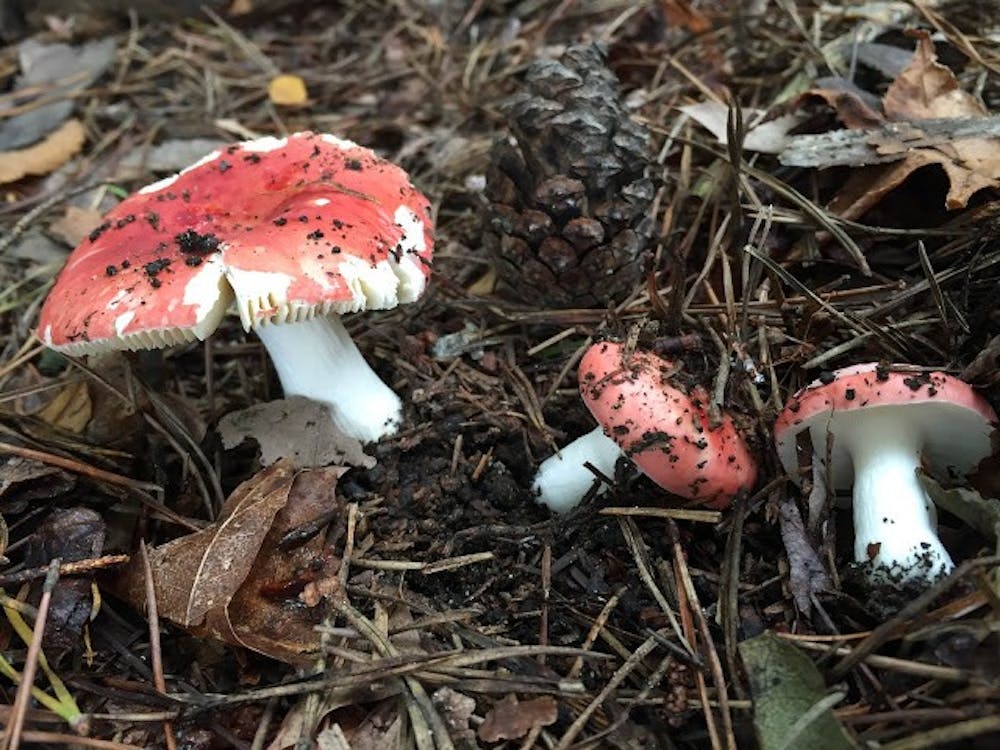On Associate Professor of Biology Antonio Izzo’s website is a link to a map that shows dozens of fungi, in all different shapes, colors and sizes, around Elon University’s campus. And he hopes that maybe, when the map is complete, it will help students wake up and smell the mushrooms.
“You see all of these beautiful trees and plants around here, but we got these beautiful other organisms as well,” Izzo said. “They’re just not as easy to see and find, so I thought it would be neat to start raising people’s awareness of this other kingdom of life that lives out there.”
Izzo’s Campus Fungi Project, which started Oct. 1 and will last until at least the end of spring semester, is looking to be a long-term fungi database for students and professors to use while highlighting Elon’s biodiversity.
Anyone who wants to get involved can send Izzo a GPS-tagged photo of fungi found on campus, and he will add it to the map.
Through the crowdsourcing aspect of the project, more than 100 fungi have been mapped so far. Izzo said anyone can help, even those who aren’t experts in mycology, the study of fungi.
“This does not require high technology,” Izzo said. “If you have a cell phone and GPS embedded, and happen to see something cool, you take a picture of it. So now instead of me walking around campus by myself and being very limited as to how much area I can cover and my own biases, it’s a fungal foray at full blast.”
Year of fungi at Elon
The duration of the project stems from fungi’s seasonal nature, with a variety of different species being exclusive to the fall or the spring. With enough participation, the map will become a snapshot of what one year of fungi looks like at Elon.
“Theoretically, if I wanted to go back and find a species [of fungi], I have the GPS location, I can look next year at this same time, and it could be out there,” Izzo said. “It opens the door for fungi research projects and other neat opportunities like that.”
The fungi kingdom is varied, containing molds, yeast and mildews, but it most popularly contains mushrooms. After Elon’s dry summer followed by the long stretch of rain, fall 2015 was the perfect opportunity to find different mushrooms around campus.
“Knowing we had so many cool things coming up with mushrooms and things like that, it seems like a really neat opportunity to jump out there and start documenting some of this as a way of raising awareness of this group of organisms that’s right here under our noses,” Izzo said.
Danieley Neighborhood and Elon University Forest have the majority of the fungi documented to this point, but areas near Belk Library and Rhodes Stadium have also been reliable sources of fungi. The ground covered on the map is expansive, thanks to the 12 contributors so far.
“It’s an interesting project, and I’m glad it’s starting now, especially going into the winter months where there will be less opportunities to take pictures,” said junior and biology major Jordan Finizio.
Not all contributors are in the biology field, with Associate Professor of Art History Evan Gatti and freshman Ana Taveira chipping in as well.
“I heard about the project on the Biology Club group page, and I thought it would be good to help out,” Taveira said. “I took some pictures around the lake and Danieley and found some cool stuff.”
The role of fungi
According to the website of Kew Gardens, a botanic garden near London, fungi have a crucial impact in the environment and in society. Besides being part of an ecosystem’s nutrient cycle and exchange process, fungi can provide assistance to plants and be a source of antibiotics or cholesterol medicine.
“They provide fundamental products including foods, medicines and enzymes important to industry,” a section of the Kew website reads. “They are also the unsung heroes of nearly all terrestrial ecosystems, hidden from view but inseparable from the processes that sustain life on the planet.”
Izzo is no stranger to fungi’s importance — he earned his Ph.D. at the University of California at Berkeley’s Department of Plant and Microbial Biology.
He said studies show the diversity of fungi is correlated with the diversity of plants, and fungi can be very diverse — some live on an unseen dead root in the ground, some live off the nutrients of degraded materials and others have a symbiotic relationships with trees.
“When you have the tables laid out with these hundreds of different mushrooms in there, it really hits you how diverse they are, and you see all these things that were probably right under your feet,” Izzo said. “We all look for different kinds of things when we search for fungi, so that’s something that’s always been one of my fondest memories of all the mycology I’ve done over the years.”
Students can send pictures of fungi on campus to Izzo at aizzo@elon.edu, as long as the pictures can be geo-located.


